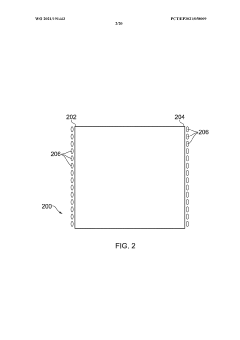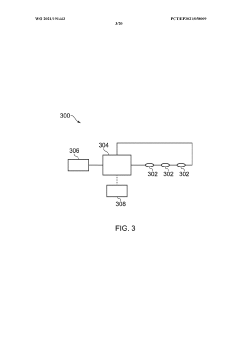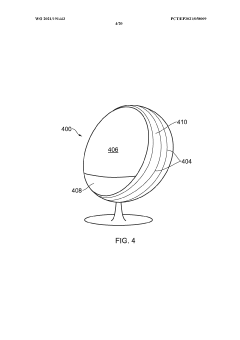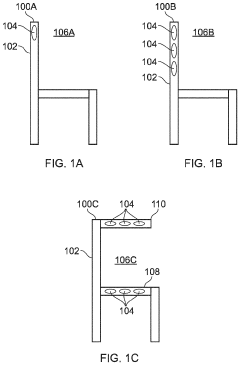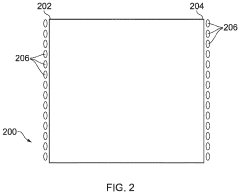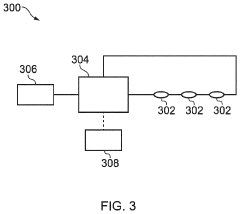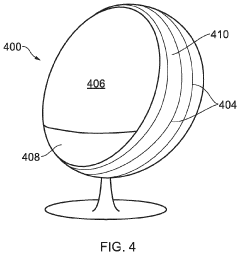How to Study Schumann Resonance Effects on Human Well‑Being?
JUN 24, 20259 MIN READ
Generate Your Research Report Instantly with AI Agent
Patsnap Eureka helps you evaluate technical feasibility & market potential.
Schumann Resonance Background and Research Objectives
Schumann resonances, discovered by physicist Winfried Otto Schumann in 1952, are electromagnetic waves that exist in the Earth's ionosphere cavity. These resonances occur at extremely low frequencies, with the fundamental frequency around 7.83 Hz. The study of Schumann resonance effects on human well-being has gained increasing attention in recent years, as researchers explore potential connections between these natural electromagnetic phenomena and human physiology.
The Earth's ionosphere and surface form a natural waveguide that captures electromagnetic waves generated by lightning discharges. These waves resonate at specific frequencies, creating a constant background of electromagnetic activity. The fundamental Schumann resonance frequency closely aligns with the alpha and theta brainwave patterns in humans, leading to speculation about possible interactions between these natural frequencies and human biological processes.
Research in this field aims to investigate the potential impacts of Schumann resonances on various aspects of human health and well-being. This includes examining effects on sleep patterns, cognitive function, stress levels, and overall physiological balance. Some studies suggest that exposure to Schumann resonance frequencies may have beneficial effects on human health, potentially influencing circadian rhythms and promoting relaxation.
The objectives of studying Schumann resonance effects on human well-being are multifaceted. Researchers seek to establish clear, scientifically validated connections between these natural electromagnetic phenomena and human physiological responses. This involves developing robust methodologies for measuring and analyzing the impact of Schumann resonances on various biological markers and health indicators.
Another key goal is to explore potential therapeutic applications of Schumann resonance frequencies. This includes investigating whether artificial recreation of these frequencies in controlled environments could offer health benefits, particularly in settings where natural exposure is limited, such as in urban areas or space travel.
Furthermore, research aims to understand the mechanisms by which Schumann resonances might influence human biology. This involves exploring potential interactions with the human bioelectromagnetic field, cellular processes, and neurological functions. By elucidating these mechanisms, researchers hope to gain deeper insights into the relationship between environmental electromagnetic fields and human health.
As technology continues to alter our electromagnetic environment, studying Schumann resonances also serves to assess the importance of maintaining connection to natural electromagnetic rhythms. This research may inform strategies for mitigating potential negative effects of artificial electromagnetic fields and guide the development of technologies that harmonize with natural frequencies.
The Earth's ionosphere and surface form a natural waveguide that captures electromagnetic waves generated by lightning discharges. These waves resonate at specific frequencies, creating a constant background of electromagnetic activity. The fundamental Schumann resonance frequency closely aligns with the alpha and theta brainwave patterns in humans, leading to speculation about possible interactions between these natural frequencies and human biological processes.
Research in this field aims to investigate the potential impacts of Schumann resonances on various aspects of human health and well-being. This includes examining effects on sleep patterns, cognitive function, stress levels, and overall physiological balance. Some studies suggest that exposure to Schumann resonance frequencies may have beneficial effects on human health, potentially influencing circadian rhythms and promoting relaxation.
The objectives of studying Schumann resonance effects on human well-being are multifaceted. Researchers seek to establish clear, scientifically validated connections between these natural electromagnetic phenomena and human physiological responses. This involves developing robust methodologies for measuring and analyzing the impact of Schumann resonances on various biological markers and health indicators.
Another key goal is to explore potential therapeutic applications of Schumann resonance frequencies. This includes investigating whether artificial recreation of these frequencies in controlled environments could offer health benefits, particularly in settings where natural exposure is limited, such as in urban areas or space travel.
Furthermore, research aims to understand the mechanisms by which Schumann resonances might influence human biology. This involves exploring potential interactions with the human bioelectromagnetic field, cellular processes, and neurological functions. By elucidating these mechanisms, researchers hope to gain deeper insights into the relationship between environmental electromagnetic fields and human health.
As technology continues to alter our electromagnetic environment, studying Schumann resonances also serves to assess the importance of maintaining connection to natural electromagnetic rhythms. This research may inform strategies for mitigating potential negative effects of artificial electromagnetic fields and guide the development of technologies that harmonize with natural frequencies.
Market Analysis for Schumann Resonance Applications
The market for Schumann Resonance applications is experiencing significant growth, driven by increasing interest in alternative health practices and the potential benefits of natural electromagnetic frequencies on human well-being. As awareness of the Schumann Resonance phenomenon grows, various industries are exploring its applications, creating a diverse and expanding market landscape.
The healthcare sector represents a primary market for Schumann Resonance applications. With a growing emphasis on holistic and integrative medicine, healthcare providers are exploring non-invasive therapies that leverage natural electromagnetic frequencies. This has led to the development of Schumann Resonance-based devices for stress reduction, sleep improvement, and overall wellness enhancement. The global complementary and alternative medicine market, which includes such therapies, is projected to continue its robust growth in the coming years.
Another significant market segment is the wellness and personal care industry. Consumer demand for natural and non-pharmaceutical solutions for stress management, relaxation, and improved sleep quality has fueled the development of Schumann Resonance-based products for home use. These include personal resonance devices, sleep aids, and meditation tools that claim to replicate or enhance the natural 7.83 Hz frequency.
The workplace wellness market also presents opportunities for Schumann Resonance applications. As companies increasingly focus on employee well-being and productivity, there is growing interest in technologies that can potentially reduce stress and improve cognitive function in office environments. This has led to the development of Schumann Resonance generators for use in corporate settings.
The research and education sector represents another expanding market for Schumann Resonance applications. Universities and research institutions are investing in equipment and technologies to study the effects of these natural frequencies on human physiology and cognition. This academic interest is driving demand for specialized research tools and measurement devices.
Environmental monitoring and geophysical research industries also contribute to the market growth. As climate change and environmental concerns become more pressing, there is increased demand for technologies that can monitor and analyze Earth's electromagnetic field variations, including Schumann Resonances.
While the market shows promising growth, it faces challenges such as regulatory scrutiny and the need for more robust scientific evidence supporting the efficacy of Schumann Resonance-based interventions. As research progresses and regulatory frameworks evolve, the market is expected to mature and potentially expand into new application areas.
The healthcare sector represents a primary market for Schumann Resonance applications. With a growing emphasis on holistic and integrative medicine, healthcare providers are exploring non-invasive therapies that leverage natural electromagnetic frequencies. This has led to the development of Schumann Resonance-based devices for stress reduction, sleep improvement, and overall wellness enhancement. The global complementary and alternative medicine market, which includes such therapies, is projected to continue its robust growth in the coming years.
Another significant market segment is the wellness and personal care industry. Consumer demand for natural and non-pharmaceutical solutions for stress management, relaxation, and improved sleep quality has fueled the development of Schumann Resonance-based products for home use. These include personal resonance devices, sleep aids, and meditation tools that claim to replicate or enhance the natural 7.83 Hz frequency.
The workplace wellness market also presents opportunities for Schumann Resonance applications. As companies increasingly focus on employee well-being and productivity, there is growing interest in technologies that can potentially reduce stress and improve cognitive function in office environments. This has led to the development of Schumann Resonance generators for use in corporate settings.
The research and education sector represents another expanding market for Schumann Resonance applications. Universities and research institutions are investing in equipment and technologies to study the effects of these natural frequencies on human physiology and cognition. This academic interest is driving demand for specialized research tools and measurement devices.
Environmental monitoring and geophysical research industries also contribute to the market growth. As climate change and environmental concerns become more pressing, there is increased demand for technologies that can monitor and analyze Earth's electromagnetic field variations, including Schumann Resonances.
While the market shows promising growth, it faces challenges such as regulatory scrutiny and the need for more robust scientific evidence supporting the efficacy of Schumann Resonance-based interventions. As research progresses and regulatory frameworks evolve, the market is expected to mature and potentially expand into new application areas.
Current State and Challenges in Schumann Resonance Research
Research on Schumann Resonance (SR) effects on human well-being is currently in a state of growing interest but faces several challenges. The scientific community has made significant strides in understanding the basic principles of SR and its potential interactions with biological systems. However, the field is still in its early stages, with many aspects requiring further investigation and validation.
One of the primary challenges in SR research is the difficulty in isolating SR effects from other environmental factors. The Earth's electromagnetic field is complex, with multiple sources of electromagnetic radiation influencing living organisms. Researchers must develop sophisticated methodologies to differentiate SR-specific effects from those caused by other electromagnetic phenomena or environmental variables.
Another significant hurdle is the lack of standardized measurement protocols and equipment for SR studies. Different research groups often use varying methodologies and instruments, making it challenging to compare results across studies. This inconsistency hampers the establishment of a robust body of evidence and slows down the progress in understanding SR's impact on human well-being.
The interdisciplinary nature of SR research presents both opportunities and challenges. While it allows for diverse perspectives and approaches, it also requires collaboration between experts from various fields such as physics, biology, neuroscience, and medicine. Coordinating these multidisciplinary efforts and integrating findings from different domains remains a complex task.
Ethical considerations and regulatory frameworks pose additional challenges. As research progresses towards potential therapeutic applications, ensuring the safety and efficacy of SR-based interventions becomes crucial. Developing appropriate clinical trial protocols and obtaining regulatory approvals for SR-related treatments or devices is a time-consuming and resource-intensive process.
The current state of SR research also faces skepticism from parts of the scientific community. Some researchers question the biological relevance of SR, citing the relatively weak intensity of these resonances compared to other electromagnetic fields humans encounter daily. Overcoming this skepticism requires rigorous, well-designed studies that can demonstrate clear and reproducible effects of SR on human physiology and well-being.
Despite these challenges, recent advancements in technology and research methodologies are opening new avenues for SR studies. High-sensitivity magnetometers and advanced signal processing techniques are improving our ability to detect and analyze SR signals. Additionally, the growing field of bioelectromagnetics is providing new insights into how weak electromagnetic fields, including SR, might interact with biological systems at the cellular and molecular levels.
One of the primary challenges in SR research is the difficulty in isolating SR effects from other environmental factors. The Earth's electromagnetic field is complex, with multiple sources of electromagnetic radiation influencing living organisms. Researchers must develop sophisticated methodologies to differentiate SR-specific effects from those caused by other electromagnetic phenomena or environmental variables.
Another significant hurdle is the lack of standardized measurement protocols and equipment for SR studies. Different research groups often use varying methodologies and instruments, making it challenging to compare results across studies. This inconsistency hampers the establishment of a robust body of evidence and slows down the progress in understanding SR's impact on human well-being.
The interdisciplinary nature of SR research presents both opportunities and challenges. While it allows for diverse perspectives and approaches, it also requires collaboration between experts from various fields such as physics, biology, neuroscience, and medicine. Coordinating these multidisciplinary efforts and integrating findings from different domains remains a complex task.
Ethical considerations and regulatory frameworks pose additional challenges. As research progresses towards potential therapeutic applications, ensuring the safety and efficacy of SR-based interventions becomes crucial. Developing appropriate clinical trial protocols and obtaining regulatory approvals for SR-related treatments or devices is a time-consuming and resource-intensive process.
The current state of SR research also faces skepticism from parts of the scientific community. Some researchers question the biological relevance of SR, citing the relatively weak intensity of these resonances compared to other electromagnetic fields humans encounter daily. Overcoming this skepticism requires rigorous, well-designed studies that can demonstrate clear and reproducible effects of SR on human physiology and well-being.
Despite these challenges, recent advancements in technology and research methodologies are opening new avenues for SR studies. High-sensitivity magnetometers and advanced signal processing techniques are improving our ability to detect and analyze SR signals. Additionally, the growing field of bioelectromagnetics is providing new insights into how weak electromagnetic fields, including SR, might interact with biological systems at the cellular and molecular levels.
Existing Methodologies for Studying Schumann Resonance Effects
01 Devices for generating Schumann resonance frequencies
Various devices have been developed to generate Schumann resonance frequencies for improving human well-being. These devices aim to simulate the natural electromagnetic frequencies of the Earth to promote relaxation, reduce stress, and enhance overall health. Some devices are designed for personal use, while others are intended for larger spaces or therapeutic settings.- Devices for generating Schumann resonance frequencies: Various devices have been developed to generate Schumann resonance frequencies for improving human well-being. These devices aim to simulate the natural electromagnetic frequencies of the Earth, which are believed to have positive effects on human health and mental state. The devices may include electromagnetic field generators, sound systems, or specialized chambers that create an environment mimicking the Earth's natural resonance.
- Therapeutic applications of Schumann resonance: Research has explored the therapeutic applications of Schumann resonance for human well-being. Studies suggest that exposure to these frequencies may have beneficial effects on stress reduction, sleep quality, and overall health. Therapeutic methods may involve controlled exposure to Schumann resonance frequencies through various means, including specialized equipment or environmental modifications.
- Wearable devices incorporating Schumann resonance technology: Wearable devices have been developed to provide individuals with continuous exposure to Schumann resonance frequencies. These devices may take the form of bracelets, pendants, or other accessories that generate or transmit the desired frequencies. The aim is to offer a portable solution for maintaining alignment with Earth's natural electromagnetic field throughout daily activities.
- Integration of Schumann resonance in living spaces: Efforts have been made to incorporate Schumann resonance technology into living spaces to create environments conducive to well-being. This may involve the installation of specialized equipment in homes, offices, or therapeutic settings to generate or amplify Schumann resonance frequencies. The goal is to provide a constant beneficial electromagnetic environment in areas where people spend significant amounts of time.
- Monitoring and analysis of Schumann resonance effects: Systems and methods have been developed for monitoring and analyzing the effects of Schumann resonance on human well-being. These may include sensors and devices to measure physiological responses, as well as software for data analysis and interpretation. Such systems aim to provide quantitative evidence of the impact of Schumann resonance exposure on various aspects of health and wellness.
02 Wearable devices incorporating Schumann resonance technology
Wearable devices have been created to deliver Schumann resonance frequencies directly to the user. These devices may include bracelets, necklaces, or other accessories that can be worn on the body. They are designed to provide continuous exposure to beneficial frequencies, potentially improving sleep quality, reducing stress, and enhancing overall well-being.Expand Specific Solutions03 Integration of Schumann resonance in therapeutic environments
Schumann resonance technology has been incorporated into therapeutic environments such as meditation rooms, wellness centers, and healthcare facilities. These systems aim to create a harmonious electromagnetic environment that supports healing, relaxation, and overall well-being. The integration may involve specialized lighting, sound systems, or electromagnetic field generators.Expand Specific Solutions04 Combination of Schumann resonance with other therapies
Researchers and inventors have explored combining Schumann resonance technology with other therapeutic modalities to enhance their effectiveness. This may include integration with light therapy, sound therapy, or other forms of energy healing. The goal is to create synergistic effects that promote better health outcomes and improved well-being.Expand Specific Solutions05 Monitoring and analysis of Schumann resonance effects on human health
Systems and methods have been developed to monitor and analyze the effects of Schumann resonance on human health and well-being. These may include sensors and devices that measure physiological responses, brain activity, or other health indicators in relation to exposure to Schumann resonance frequencies. The data collected can be used to optimize therapeutic applications and further understand the impact of these frequencies on human health.Expand Specific Solutions
Key Players in Schumann Resonance Research
The study of Schumann Resonance effects on human well-being is an emerging field at the intersection of geophysics and health sciences. The market is in its early stages, with a growing interest from both academic institutions and private companies. While the market size is currently limited, it shows potential for expansion as research progresses. Technologically, the field is still developing, with varying levels of maturity among key players. Universities like the University of Bern and the University of California are conducting foundational research, while companies such as Wave Neuroscience, Inc. and Bioself Technology Ltd. are exploring practical applications. The involvement of established medical technology firms like Cardiac Pacemakers, Inc. and Covidien Pte Ltd. suggests a growing recognition of the potential health implications of Schumann Resonance.
Wave Neuroscience, Inc.
Technical Solution: Wave Neuroscience has developed a proprietary technology called Transcranial Electrical Stimulation (TES) that can potentially be used to study Schumann Resonance effects on human well-being. Their approach involves using precise, low-intensity electrical currents to modulate brain activity. By synchronizing these currents with Schumann Resonance frequencies, they aim to investigate the potential impact on various aspects of human health, including stress reduction, sleep quality, and cognitive function. The company's research focuses on developing protocols that can effectively entrain brain waves to these natural Earth frequencies, potentially enhancing the body's natural healing processes and overall well-being.
Strengths: Cutting-edge neurotechnology, non-invasive approach, potential for personalized treatments. Weaknesses: Limited long-term studies, potential regulatory hurdles, need for further validation of Schumann Resonance effects.
University of Bern
Technical Solution: The University of Bern has been conducting research on the effects of Schumann Resonances on human well-being through their interdisciplinary approach. Their methodology involves using high-sensitivity magnetometers to measure the Earth's magnetic field variations and correlate them with human physiological responses. They have developed a specialized laboratory setting that can isolate subjects from external electromagnetic influences while exposing them to controlled Schumann Resonance-like frequencies. Their research protocol includes monitoring various biomarkers such as heart rate variability, cortisol levels, and EEG patterns to assess the impact of these frequencies on stress levels, sleep quality, and cognitive performance. The university's team is also exploring the potential therapeutic applications of Schumann Resonance exposure in treating conditions like insomnia and anxiety disorders.
Strengths: Rigorous scientific approach, interdisciplinary collaboration, advanced measurement techniques. Weaknesses: Limited sample sizes in studies, challenges in replicating Earth's complex electromagnetic environment, potential placebo effects.
Critical Findings in Schumann Resonance and Human Health
A magnetic field exposure system and uses thereof
PatentWO2021191443A1
Innovation
- A magnetic field exposure system generating an amplitude-modulated low frequency magnetic field with a carrier frequency of 360 to 450 Hz and a modulation frequency of 0.5 to 100 Hz, with a field strength of 0.5 to 250 mT, specifically designed to expose organic cells or tissues to improve cell survival, proliferation, reduce stress, and enhance well-being.
A magnetic field exposure system and uses thereof
PatentPendingUS20230372726A1
Innovation
- A magnetic field exposure system generating an amplitude-modulated low frequency magnetic field with a carrier frequency of 360 to 450 Hz and a modulation frequency of 0.5 to 100 Hz, providing a field strength of 0.5 to 250 μT, specifically designed to enhance cell survival, proliferation, reduce stress, and promote tissue regeneration.
Regulatory Framework for Electromagnetic Field Studies
The regulatory framework for electromagnetic field (EMF) studies, particularly those focused on Schumann Resonance (SR) effects on human well-being, is a complex and evolving landscape. Various international and national bodies have established guidelines and standards to ensure the safety and reliability of EMF research.
At the international level, the World Health Organization (WHO) plays a crucial role in coordinating global efforts to assess health risks associated with EMF exposure. The WHO's International EMF Project provides a framework for harmonizing EMF standards worldwide and promotes research to fill knowledge gaps. This project collaborates with the International Commission on Non-Ionizing Radiation Protection (ICNIRP), which develops guidelines for EMF exposure limits based on scientific evidence.
In the United States, the Federal Communications Commission (FCC) sets guidelines for human exposure to radiofrequency electromagnetic fields. These guidelines are based on recommendations from the National Council on Radiation Protection and Measurements (NCRP) and the Institute of Electrical and Electronics Engineers (IEEE). The Environmental Protection Agency (EPA) and the Food and Drug Administration (FDA) also contribute to the regulatory framework by conducting research and providing guidance on EMF-related health issues.
The European Union has established the EMF Directive (2013/35/EU), which sets minimum health and safety requirements regarding the exposure of workers to risks arising from electromagnetic fields. This directive is based on guidelines from ICNIRP and is implemented by individual EU member states through national legislation.
For SR studies specifically, researchers must adhere to ethical guidelines for human subject research, as outlined by bodies such as the World Medical Association's Declaration of Helsinki and national ethics committees. These guidelines ensure that studies involving human participants are conducted with proper informed consent, minimal risk, and respect for individual rights and privacy.
Given the interdisciplinary nature of SR research, which spans physics, biology, and medicine, researchers must also comply with regulations specific to each field. This includes adherence to good laboratory practices, proper calibration of measurement equipment, and standardized protocols for data collection and analysis.
As the field of SR research evolves, regulatory bodies are likely to update their guidelines to reflect new scientific findings. Researchers must stay informed about these changes and adapt their study designs accordingly to ensure compliance and maintain the validity of their results.
At the international level, the World Health Organization (WHO) plays a crucial role in coordinating global efforts to assess health risks associated with EMF exposure. The WHO's International EMF Project provides a framework for harmonizing EMF standards worldwide and promotes research to fill knowledge gaps. This project collaborates with the International Commission on Non-Ionizing Radiation Protection (ICNIRP), which develops guidelines for EMF exposure limits based on scientific evidence.
In the United States, the Federal Communications Commission (FCC) sets guidelines for human exposure to radiofrequency electromagnetic fields. These guidelines are based on recommendations from the National Council on Radiation Protection and Measurements (NCRP) and the Institute of Electrical and Electronics Engineers (IEEE). The Environmental Protection Agency (EPA) and the Food and Drug Administration (FDA) also contribute to the regulatory framework by conducting research and providing guidance on EMF-related health issues.
The European Union has established the EMF Directive (2013/35/EU), which sets minimum health and safety requirements regarding the exposure of workers to risks arising from electromagnetic fields. This directive is based on guidelines from ICNIRP and is implemented by individual EU member states through national legislation.
For SR studies specifically, researchers must adhere to ethical guidelines for human subject research, as outlined by bodies such as the World Medical Association's Declaration of Helsinki and national ethics committees. These guidelines ensure that studies involving human participants are conducted with proper informed consent, minimal risk, and respect for individual rights and privacy.
Given the interdisciplinary nature of SR research, which spans physics, biology, and medicine, researchers must also comply with regulations specific to each field. This includes adherence to good laboratory practices, proper calibration of measurement equipment, and standardized protocols for data collection and analysis.
As the field of SR research evolves, regulatory bodies are likely to update their guidelines to reflect new scientific findings. Researchers must stay informed about these changes and adapt their study designs accordingly to ensure compliance and maintain the validity of their results.
Ethical Considerations in Human Subjects Research
When studying the effects of Schumann Resonance on human well-being, ethical considerations in human subjects research are paramount. The research must adhere to established ethical guidelines and principles to protect participants' rights, safety, and welfare.
Informed consent is a crucial aspect of ethical research. Participants must be fully informed about the study's purpose, procedures, potential risks, and benefits. They should have the freedom to decide whether to participate and the right to withdraw at any time without consequences. The consent process should be documented and approved by an institutional review board (IRB) or ethics committee.
Privacy and confidentiality of participants' data must be rigorously maintained. Researchers should implement robust data protection measures, including secure storage, anonymization, and restricted access to sensitive information. Participants should be informed about how their data will be used, stored, and potentially shared.
The principle of beneficence requires that the potential benefits of the research outweigh the risks. Researchers must carefully assess and minimize any potential physical, psychological, or social risks associated with exposure to Schumann Resonance. They should also consider the long-term implications of the study on participants' well-being.
Justice and fairness in participant selection are essential. The study should aim for a diverse and representative sample, avoiding unnecessary exclusion of certain groups. Researchers must ensure that the benefits and burdens of the research are equitably distributed among different populations.
Vulnerable populations, such as children, pregnant women, or individuals with mental health conditions, require special protection. If included in the study, additional safeguards and considerations must be implemented to ensure their rights and well-being are adequately protected.
Transparency in research methods and reporting of results is crucial for maintaining ethical standards. Researchers should commit to publishing both positive and negative findings to avoid publication bias and contribute to the overall scientific understanding of Schumann Resonance effects.
Continuous monitoring and oversight of the research process are necessary to address any unforeseen ethical issues that may arise during the study. This may include establishing a data safety monitoring board or regular ethics committee reviews to ensure ongoing compliance with ethical standards.
Human Enhancement Research: Ethical Considerations in Human Subjects Research
Informed consent is a crucial aspect of ethical research. Participants must be fully informed about the study's purpose, procedures, potential risks, and benefits. They should have the freedom to decide whether to participate and the right to withdraw at any time without consequences. The consent process should be documented and approved by an institutional review board (IRB) or ethics committee.
Privacy and confidentiality of participants' data must be rigorously maintained. Researchers should implement robust data protection measures, including secure storage, anonymization, and restricted access to sensitive information. Participants should be informed about how their data will be used, stored, and potentially shared.
The principle of beneficence requires that the potential benefits of the research outweigh the risks. Researchers must carefully assess and minimize any potential physical, psychological, or social risks associated with exposure to Schumann Resonance. They should also consider the long-term implications of the study on participants' well-being.
Justice and fairness in participant selection are essential. The study should aim for a diverse and representative sample, avoiding unnecessary exclusion of certain groups. Researchers must ensure that the benefits and burdens of the research are equitably distributed among different populations.
Vulnerable populations, such as children, pregnant women, or individuals with mental health conditions, require special protection. If included in the study, additional safeguards and considerations must be implemented to ensure their rights and well-being are adequately protected.
Transparency in research methods and reporting of results is crucial for maintaining ethical standards. Researchers should commit to publishing both positive and negative findings to avoid publication bias and contribute to the overall scientific understanding of Schumann Resonance effects.
Continuous monitoring and oversight of the research process are necessary to address any unforeseen ethical issues that may arise during the study. This may include establishing a data safety monitoring board or regular ethics committee reviews to ensure ongoing compliance with ethical standards.
Human Enhancement Research: Ethical Considerations in Human Subjects Research
Unlock deeper insights with Patsnap Eureka Quick Research — get a full tech report to explore trends and direct your research. Try now!
Generate Your Research Report Instantly with AI Agent
Supercharge your innovation with Patsnap Eureka AI Agent Platform!

